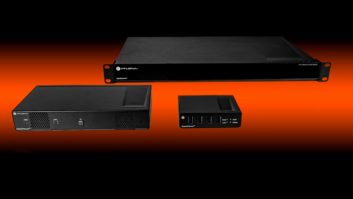With the high profile of new, innovative technology – and the rate at which it is being adopted in all areas of business and everyday life – it is sometimes easy to forget that older technologies still exist and continue to be used. The basic keyboard, video and mouse (KVM) set-up is a classic example of this. Just about everyone still uses this well-established interface to run their computers today, with wireless connectivity being about the only concession to the modern world.
Away from home computing, KVM similarly continues to play a major role in the broad world of wherever AV equipment is used. While the installation, live sound and commercial audio and video sectors may be readily adopted touch screens and virtualisation – both for remote operations and off-site processing and data storage – KVM is still there in some shape or form. The reason for its longevity, aside from the reassurance of a familiar user interface, can be put down to the technology’s ability to adapt and evolve with time.
The original concept of a KVM hardware matrix switch controlling multiple computers from one, possibly more, combinations of a keyboard, a video monitor and a mouse has been taken further through the implementation of IP control and connectivity technologies. This modern incarnation of KVM has, comments Jamie Adkin, vice president of sales for EMEA at Adder Technology, lends itself well to several areas that come under the heading of professional AV.

These include: auditoria and events spaces; theatre and live performances such as festivals; museums and other public environments; and command and control for the transport, energy and security sectors. Adkin explains that in the first category, the users are usually part of a production team, often based in a control room and running the event. He adds that in these situations KVM over IP enables more widespread control and networking than something based on AV over IP (AVoIP), which is typically deployed for a single system.
“For theatres and live shows, KVM enables operation of lighting and other show control,” he comments. “Museums and public places are more point-to-point, with extenders connecting to interactive touch screens. The computer controlling this would usually be in a server room, with KVM plus IP providing matrix facilities such as switching and management. In the fourth use case, customers might see command and control as separate but it is still pro AV.”
Adkin views the advantages of IP KVM as the ability to build a system to any scale, involving more than 1000 end points, very low latency and high frame rates. “Anyone with a KVM receiver can access a large-scale network like that,” he adds, “although most operators do not want everyone to be able to do that. Even today, 95 percent of users are at a desk with a mouse and a computer. KVM provides one system and the necessary switching tools, as opposed to AVoIP, which requires third party devices to switch sources.”
KVM IMPACT
The impact of IP KVM on the AV industry is also acknowledged by Thomas Tang, president of Apantac. “It has become an important part of pro AV,” he says. “More large companies are building event centres and being able to move any source to any destination is now a common requirement. There are traditional KVMs, which is a local switch that can change over between operator/user stations and their sources. But this usually has a mechanical limitation on how many destinations (users) and how many sources (computers) there can be in these systems. With IP KVM, there are no limitations to how many destinations and how many sources there are. It is now used in many different industries from pro AV to broadcast to factory automation and more.”
 Tang divides KVM technology into three main types: the traditional KVM switch, which he says is suitable for small systems with all equipment located relatively close to each other and connected over video (HDMI, DVI, VGA) cables; point-to-point extenders; and IP KVM, which can run on 1G or 10G networks, with IP over Ethernet increasingly being used as the carrier technology. “Of the two, 1G is more popular mainly due to the cost of the infrastructure,” he says. “We’re also seeing a trend of facilities moving towards 4K/UHD 60, with a lot of people requesting it at InfoComm 2023. We’re also experiencing a rise in the use of multi-viewers with built-in KVM capabilities.”
Tang divides KVM technology into three main types: the traditional KVM switch, which he says is suitable for small systems with all equipment located relatively close to each other and connected over video (HDMI, DVI, VGA) cables; point-to-point extenders; and IP KVM, which can run on 1G or 10G networks, with IP over Ethernet increasingly being used as the carrier technology. “Of the two, 1G is more popular mainly due to the cost of the infrastructure,” he says. “We’re also seeing a trend of facilities moving towards 4K/UHD 60, with a lot of people requesting it at InfoComm 2023. We’re also experiencing a rise in the use of multi-viewers with built-in KVM capabilities.”
According to Jochen Bauer, director of sales at Guntermann & Drunck (G&D), there has been a “continuous shift” towards more IP-based systems for several years. “Being able to use standard network components makes the use of IP KVM particularly interesting because existing IT installations can be scaled more easily, flexibly and cost-effectively,” he says. “Existing structures can also be used depending on the demand of the application. Almost all components are plug and play devices, which makes it even easier and more comfortable to operate the system.”
BETTER SOLUTION
Even with the “many advantages” of IP-based systems, Bauer observes that “classic KVM” still finds its uses in a large variety of applications and “can sometimes be the better solution”. In general, he adds, the key aspect is interoperability, which enables “independent, heterogeneous systems” to work together seamlessly. “The IT landscape is becoming increasingly complex and multifunctional. In the future it will therefore be even more important for technologies to be interoperable in order to harmonise different systems and facilitate the operation of complex scenarios. For us, it’s crucial to consider this aspect as our KVM solutions are a permanent link between IT and AV structures.”
While pro AV is the more obvious area to benefit from the application of KVM, domestic installations are another target for the technologies. “KVM will continue to play a pivotal role in both professional and high-end consumer AV entertainment room applications,” states Dan Holland, marketing manager at IHSE USA. “For both work-at-home and facility locations, systems must be designed to be interoperable with AV and broadcast standards, such as SMPTE ST 2110, NDI and others being developed for video and data transmission over a LAN/WAN system.”
 In addition to this, Holland says latency and 4K will continue to be key issues for manufacturers as their customer base moves systems away from traditional analogue or coaxial-type infrastructures. “Today’s system designers for AV signal management are going through a transition to eliminate the traditional stove piped communications concept [i.e. a rigid, hierarchical structure with no cross-organisational flow] to a more open-source infrastructure,” he says. “The ability to obtain, gather, process and distribute information effectively is key to gaining operational superiority and many system designers have found KVM switching to be an effective means to streamline data access while maintaining an important level of security and data quality.
In addition to this, Holland says latency and 4K will continue to be key issues for manufacturers as their customer base moves systems away from traditional analogue or coaxial-type infrastructures. “Today’s system designers for AV signal management are going through a transition to eliminate the traditional stove piped communications concept [i.e. a rigid, hierarchical structure with no cross-organisational flow] to a more open-source infrastructure,” he says. “The ability to obtain, gather, process and distribute information effectively is key to gaining operational superiority and many system designers have found KVM switching to be an effective means to streamline data access while maintaining an important level of security and data quality.
Holland adds that AV professionals are now asking to connect multiple monitors to a single workstation, with the aim of improving daily work productivity. “The introduction of 4K/8K KVM extenders has given users the option of either mirroring the desktop onto the alternate monitor or extending the screen so that the desktop stretches across both displays,” he says. “Next generation IP KVM will also make it much easier to remote into any computer at any location as if it is located at the user’s desk.”
SECURITY ASPECTS
An aspect of KVM that might not spring immediately to mind – but which is crucial when it comes to any computer-based operation – is security. With the ever present threat of cyber attacks, ransom strikes and infiltration, this major issue is, as John Hickey, senior director of R&D and KVM systems at Black Box, highlights, is of the greatest importance.
“While security has always been core to KVM, in the past 12 months we have seen an increasing focus on it, with more detailed questions around user rights management, access control, and cyber security,” he says. “More and more often, we see people looking for details on how we manage security and protect against attacks. Customers are particularly looking to ensure the KVM system integrates seamlessly into their networks and is a good actor within their IT framework, compatible with Active Directory, SNMP trap managers and Syslogs.”
In these days of touch screens and voice control, it could be assumed that KVM is outdated and ready to be replaced by some innovative new technology. Hickey acknowledges that while there is a move to touch panels and X-key (programmable keypad) devices, these are being used in conjunction with the existing interface infrastructure. “Touch screens and X-keys are being widely used within KVM to reduce the learning curve for operators,” he explains. “They simplify operation by eliminating the need to learn hot-key sequences or to pull up an on-screen display [OSD] and navigate through menus. It’s important to note that while KVM systems can operate with a touch-screen to allow OSD operation, not all do. To make it possible, the KVM system must feature a rich set of APIs that allow for integration with controllers, or the control device’s drivers must be embedded in the KVM receivers.”
As Hickey concludes, KVM in AV will continue to develop in relation to the main technologies being used in the field: IP networks for both self-contained installations and multiple sites, hybrid working involving physical and virtual machines and, inevitably, the cloud. As part of this, KVM may begin to become more of a background function, but it is likely to remain a key part of operations for some time to come.







